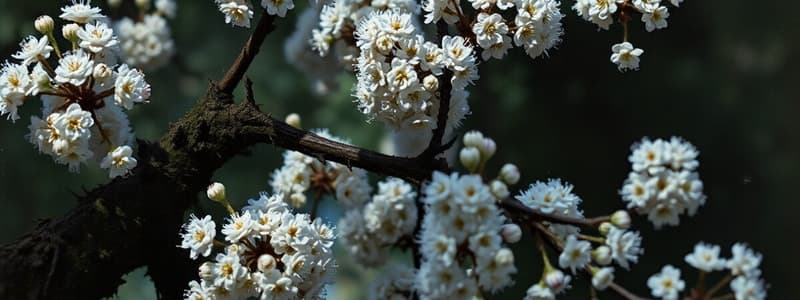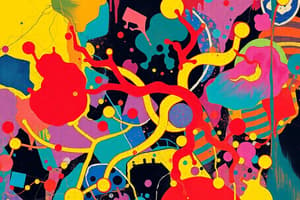Podcast
Questions and Answers
What type of lactone ring is found in cardenolides?
What type of lactone ring is found in cardenolides?
- Hexanolid
- Tetraenolide
- Pentadienolide
- Butenolide (correct)
Bufanolides have a six-membered lactone ring.
Bufanolides have a six-membered lactone ring.
False (B)
What is the structural feature present at position C-3 of cardiac glycosides?
What is the structural feature present at position C-3 of cardiac glycosides?
β-OH group
The aglycones of cardioactive glycosides are referred to as ______.
The aglycones of cardioactive glycosides are referred to as ______.
Which of the following is a type of glycoside associated with digitalis?
Which of the following is a type of glycoside associated with digitalis?
All cardioactive glycosides have unsaturated lactone rings at position C-17.
All cardioactive glycosides have unsaturated lactone rings at position C-17.
List one additional structural feature of cardioactive glycosides.
List one additional structural feature of cardioactive glycosides.
Match the type of glycosides with their corresponding aglycone:
Match the type of glycosides with their corresponding aglycone:
What is the correct nomenclature for a compound with a hydroxyl group at position 3, an oxo group at position 11, and one double bond?
What is the correct nomenclature for a compound with a hydroxyl group at position 3, an oxo group at position 11, and one double bond?
If a compound has no double bond, it is referred to as a cardanolide.
If a compound has no double bond, it is referred to as a cardanolide.
Name two constituents found in Digitalis purpurea.
Name two constituents found in Digitalis purpurea.
The biosynthesis of cardioactive glycosides originates from _____ acid.
The biosynthesis of cardioactive glycosides originates from _____ acid.
Match the following Digitalis species with their notable glycosides:
Match the following Digitalis species with their notable glycosides:
What type of glycoside does Digitalis lanata produce that is not found in Digitalis purpurea?
What type of glycoside does Digitalis lanata produce that is not found in Digitalis purpurea?
Bufadienolides arise from the condensation of a C21 steroid and a C2 unit.
Bufadienolides arise from the condensation of a C21 steroid and a C2 unit.
The derived units for positions C-22 and C-23 in cardioactive glycosides come from a _____ unit.
The derived units for positions C-22 and C-23 in cardioactive glycosides come from a _____ unit.
What is the primary mechanism of action of cardiotonic agents like K-strophanthoside?
What is the primary mechanism of action of cardiotonic agents like K-strophanthoside?
K-strophanthoside is safely administered orally.
K-strophanthoside is safely administered orally.
What are the principal glycosides found in Strophanthus kombe?
What are the principal glycosides found in Strophanthus kombe?
The leaves of ___ contain cardiac glycosides and have historically been considered poisonous.
The leaves of ___ contain cardiac glycosides and have historically been considered poisonous.
Match the following cardiac glycosides with their corresponding plants:
Match the following cardiac glycosides with their corresponding plants:
What distinguishes the genins of squill glycosides from those of cardenolides?
What distinguishes the genins of squill glycosides from those of cardenolides?
Ouabagenin is less polar than K-strophanthin.
Ouabagenin is less polar than K-strophanthin.
What is the primary therapeutic use of K-strophanthin?
What is the primary therapeutic use of K-strophanthin?
Flashcards are hidden until you start studying
Study Notes
Cardioactive Glycosides
- Characterized by their specific action on cardiac muscle, increasing tone, excitability and contractility
- Their aglycones are referred to as "cardiac genin".
- Cardiac genin are steroidal in nature, specifically, they are derivatives of cyclopentaphenanthrene containing an unsaturated lactone ring attached to C17.
Structure of Glycosides
- Two types of genin are distinguished: cardenolides and bufanolides (also known as bufadienolides).
- Cardenolide:
- Contains a butenolide (4 carbons) lactone ring attached to C17.
- Examples: digitalis and strophanthus species
- 23 carbons
- **Bufanolide (also known as Bufadienolide): **
- Contains a pentadienolide (5 carbons with 2 double bonds) lactone ring attached to C17.
- Examples: squill glycosides and bufotoxin.
- 24 carbons
Nomenclature of Cardioactive Glycosides
- Sequence:
- Arrange functional groups and denote their configuration.
- Denote whether it is α or β.
- Denote the type of glycoside.
- Denote the position of double bonds.
Biosynthesis of Cardioactive Glycosides
- Derived from mevalonic acid.
- Aglycones are derived from a condensation of a C21 steroid with a C2/C3 unit.
Drugs Containing Cardioactive Glycosides
- 1. Digitalis (Foxglove):
- Dried leaf of Digitalis purpurea (F: Scrophulariaceae)
- Contains: digitoxin, gitoxin, gitaloxin (most important), and other glycosides (purpurea glycosides A, B, gluco-gitaloxin, gluco-digitoxigenin)
- Average concentration of glycosides: 0.16%
- 2. Digitalis Lanata:
- Contains 70 glycosides derived from five different aglycones (digitoxigenin, gitoxigenin, gitaloxigenin, digoxigenin, diginatigenin)
- Digoxin and lanatoside C are primarily sourced from Digitalis lanata.
- 3. Strophanthus:
- Dried ripe seeds of Strophanthus kombe or Strophanthus hispidus (F: Apocyanaceae)
- Contains: K-strophanthoside, K-strophanthin-B, and cymarin, all based on the genin strophanthidin
- 4. Oleander:
- Leaves of Nerium oleander (F: Apocyanaceae)
- Used to treat cardiac insufficiency.
- Contains: oleanderin (promising anticancer agent)
- 5. Squill:
- Bulb of Urginea maritima (white variety) or Urginea indica (F: Liliaceae)
- Squill glycosides differ from cardenolides:
- Six-membered doubly unsaturated lactone ring at C-17
- At least one double bond in the steroid nucleus
Mechanism of Action of Cardioactive Glycosides
- Inhibit Na+/K+ ATPase enzyme.
- This enzyme keeps K+ inside the cell and Na+ outside, so when inhibited:
- K+ transport back into the cell is blocked.
- Na+ enters the cell, promoting Ca+2 entry.
- Ca+2 is essential for actin and myosin contraction.
- Used to treat congestive heart failure.
Studying That Suits You
Use AI to generate personalized quizzes and flashcards to suit your learning preferences.




